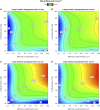Highly Efficient One-Step Protein Immobilization on Polymer Membranes Supported by Response Surface Methodology
- PMID: 35118049
- PMCID: PMC8804297
- DOI: 10.3389/fchem.2021.804698
Highly Efficient One-Step Protein Immobilization on Polymer Membranes Supported by Response Surface Methodology
Abstract
Immobilization of proteins by covalent coupling to polymeric materials offers numerous excellent advantages for various applications, however, it is usually limited by coupling strategies, which are often too expensive or complex. In this study, an electron-beam-based process for covalent coupling of the model protein bovine serum albumin (BSA) onto polyvinylidene fluoride (PVDF) flat sheet membranes was investigated. Immobilization can be performed in a clean, fast, and continuous mode of operation without any additional chemicals involved. Using the Design of Experiments (DoE) approach, nine process factors were investigated for their influence on graft yield and homogeneity. The parameters could be reduced to only four highly significant factors: BSA concentration, impregnation method, impregnation time, and electron beam irradiation dose. Subsequently, optimization of the process was performed using the Response Surface Methodology (RSM). A one-step method was developed, resulting in a high BSA grafting yield of 955 mg m-2 and a relative standard deviation of 3.6%. High efficiency was demonstrated by reusing the impregnation solution five times consecutively without reducing the final BSA grafting yield. Comprehensive characterization was conducted by X-ray photoelectron spectroscopy (XPS), Fourier-transform infrared spectroscopy (FTIR), and measurements of zeta potential, contact angle and surface free energy, as well as filtration performance. In addition, mechanical properties and morphology were examined using mercury porosimetry, tensile testing, and scanning electron microscopy (SEM).
Keywords: electron beam; polymer membrane; radiation-induced graft immobilization; response surface methodology; serum albumin; surface modification.
Copyright © 2022 Schmidt, Abdul Latif, Prager, Gläser and Schulze.
Conflict of interest statement
The authors declare that the research was conducted in the absence of any commercial or financial relationships that could be construed as a potential conflict of interest.
Figures






Similar articles
-
Reagent-Free Immobilization of Industrial Lipases to Develop Lipolytic Membranes with Self-Cleaning Surfaces.Membranes (Basel). 2022 Jun 9;12(6):599. doi: 10.3390/membranes12060599. Membranes (Basel). 2022. PMID: 35736306 Free PMC article.
-
Radiation-Induced Graft Immobilization (RIGI): Covalent Binding of Non-Vinyl Compounds on Polymer Membranes.Polymers (Basel). 2021 Jun 2;13(11):1849. doi: 10.3390/polym13111849. Polymers (Basel). 2021. PMID: 34199570 Free PMC article.
-
[Surface modification of polyvinylidene fluoride (PVDF) membrane by using the zwitterionic substance].Huan Jing Ke Xue. 2013 Oct;34(10):3945-53. Huan Jing Ke Xue. 2013. PMID: 24364315 Chinese.
-
Erratum: Preparation of Poly(pentafluorophenyl acrylate) Functionalized SiO2 Beads for Protein Purification.J Vis Exp. 2019 Apr 30;(146). doi: 10.3791/6328. J Vis Exp. 2019. PMID: 31038480
-
Preparation and Properties of Polyvinylidene Fluoride Nanocomposited Membranes based on Poly(N-Isopropylacrylamide) Modified Graphene Oxide Nanosheets.Polymers (Basel). 2019 Mar 12;11(3):473. doi: 10.3390/polym11030473. Polymers (Basel). 2019. PMID: 30960457 Free PMC article.
Cited by
-
Protein Immobilization on Bacterial Cellulose for Biomedical Application.Polymers (Basel). 2024 Aug 30;16(17):2468. doi: 10.3390/polym16172468. Polymers (Basel). 2024. PMID: 39274101 Free PMC article. Review.
-
Reagent-Free Immobilization of Industrial Lipases to Develop Lipolytic Membranes with Self-Cleaning Surfaces.Membranes (Basel). 2022 Jun 9;12(6):599. doi: 10.3390/membranes12060599. Membranes (Basel). 2022. PMID: 35736306 Free PMC article.
-
Functionalization of Poly(styrene-co-methyl methacrylate) Particles for Selective Removal of Bilirubin.Materials (Basel). 2022 Aug 30;15(17):5989. doi: 10.3390/ma15175989. Materials (Basel). 2022. PMID: 36079370 Free PMC article.
References
-
- Ahmad Khairuddin N. M., Muhammad Afifi A., Hashim N. A., Mohamad S. E., Kalantari K. (2018). Immobilization of Bovine Serum Albumin on the Chitosan/PVA Film. Jsm 47, 1311–1318. 10.17576/jsm-2018-4706-28 - DOI
-
- Akashi N., Kuroda S. (2015). Preparation and Characterization of Protein A-Immobilized PVDF and PES Membranes. Express Polym. Lett. 9, 2–13. 10.3144/expresspolymlett.2015.2 - DOI
-
- Albert R., Horwitz W. (1997). A Heuristic Derivation of the Horwitz Curve. Anal. Chem. 69, 789–790. 10.1021/ac9608376 - DOI
-
- Anderson M. J., Whitcomb P. J. (2010). “Design of Experiments,” in Kirk-Othmer Encyclopedia of Chemical Technology. Editors Kirk R. E., Othmer D. F. (Geneva: Interscience Publishers; ). 10.1002/0471238961.0405190908010814.a01.pub3 - DOI
LinkOut - more resources
Full Text Sources

